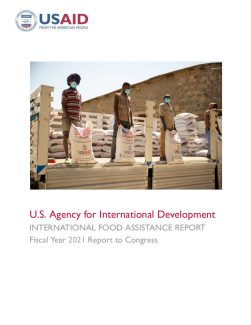Introduction
Global levels of acute food insecurity continued to rise in 2021 due to the confluence of conflict and insecurity, extreme and variable weather conditions, large-scale economic crises, and the effects of the coronavirus disease (COVID-19) pandemic. An estimated 161 million people across 42 countries were experiencing acute food insecurity in 2021 — a 19 percent increase compared to 2020.
Prolonged or intensifying conflicts were the primary drivers of the most significant food security crises in 2021, with violence and insecurity generating widespread displacement, undermining livelihoods, and disrupting access to markets and basic services. USAID’s Bureau for Humanitarian Assistance (USAID/BHA) continued to provide large-scale emergency food assistance to respond to these crises, including by addressing ongoing needs resulting from protracted conflicts in countries such as South Sudan, Syria, and Yemen, as well as heightened needs arising from evolving conflict dynamics in Afghanistan and northern Ethiopia. Conflict and violence also contributed to growing displacement globally, with an estimated 20.8 million refugees worldwide by mid-2021. USAID remained 2 the world’s largest provider of emergency food assistance to refugees, helping millions of refugees in 36 countries meet basic food needs. Meanwhile, the effects of extreme and erratic weather compounded food insecurity in several regions in 2021. For example, in southern Madagascar, severe drought significantly limited agricultural production and contributed to a growing humanitarian crisis, while in Central America, multiple years of drought followed by consecutive storms in late 2020 exacerbated food insecurity in El Salvador, Guatemala, and Honduras.
Through its Resilience Food Security Activities (RFSAs), USAID works beyond the immediate response phase to improve and sustain the food and nutrition security of vulnerable populations. These programs build on USAID’s humanitarian interventions to strengthen the ability of people, communities, countries, and systems to adapt to and recover from shocks and stresses, in a way that reduces chronic vulnerability and facilitates inclusive growth.
In FY 2021, USAID provided nearly $2.3 billion in Title II Food for Peace Act assistance, funding the procurement of nearly 1.7 million metric tons (MT) of food from the United States to serve beneficiaries in 35 countries. Nearly 86 percent of Title II assistance was for emergency responses and approximately 14 percent was for non-emergency programming. When combined with International Disaster Assistance (IDA), Economic Support Funds provided through the American Rescue Plan Act (ARPA), and Development Assistance funds provided as Community Development Funds (CDF), USAID provided a total of $4.86 billion across 59 countries with food assistance and related programs in FY 2021.
Pursuant to Section 407(f) of the Food for Peace Act (7 U.S.C. § 1736a(f)), this report provides the highlights of trends and activities in food assistance in FY 2021. The FY 2021 IFAR report also includes updates on Title II (Sec. 1007 Use of the Commodity Credit Corporation for commodities and associated expenses) funding provided through ARPA, to provide food assistance to vulnerable populations across the globe.

